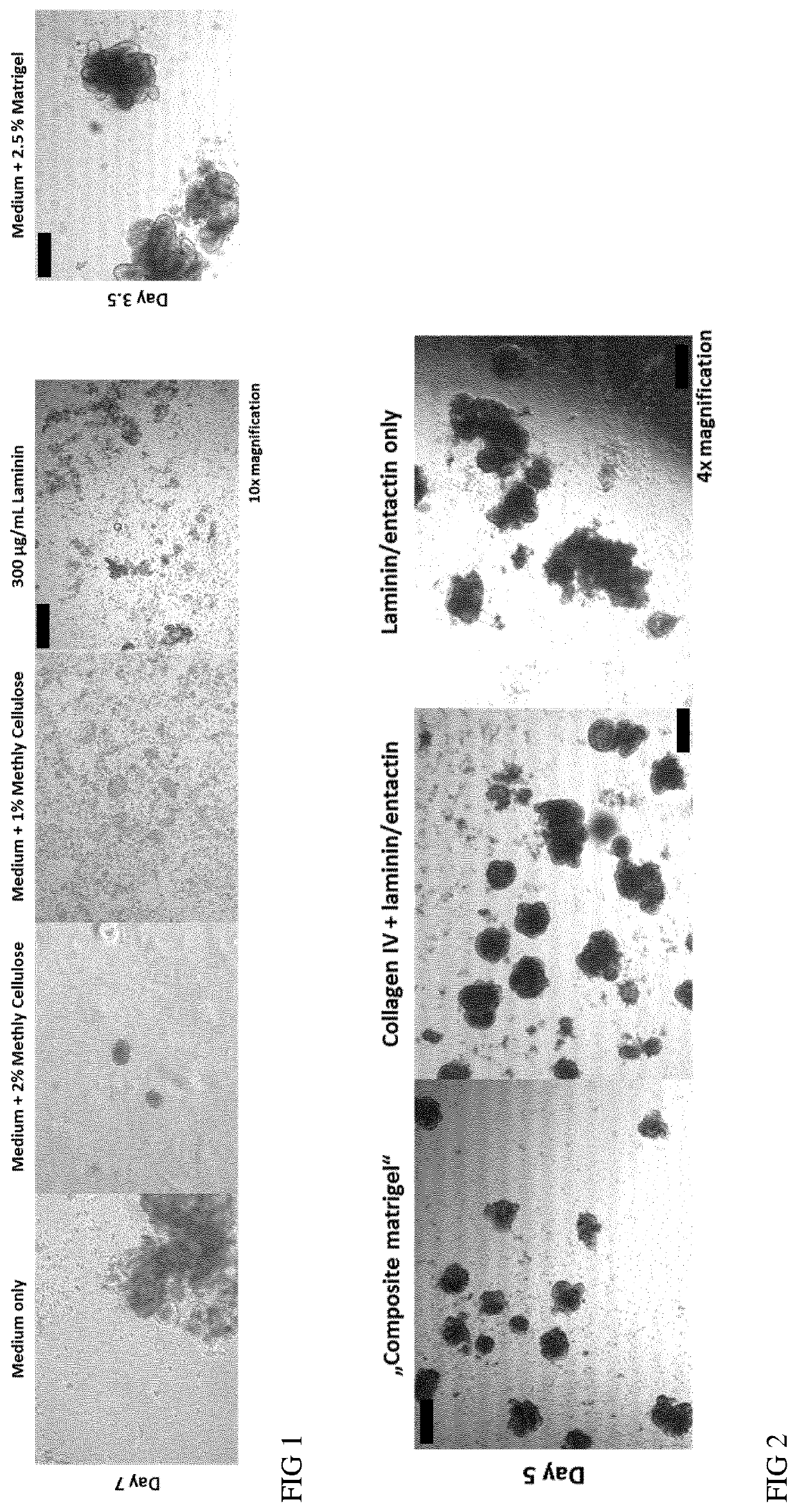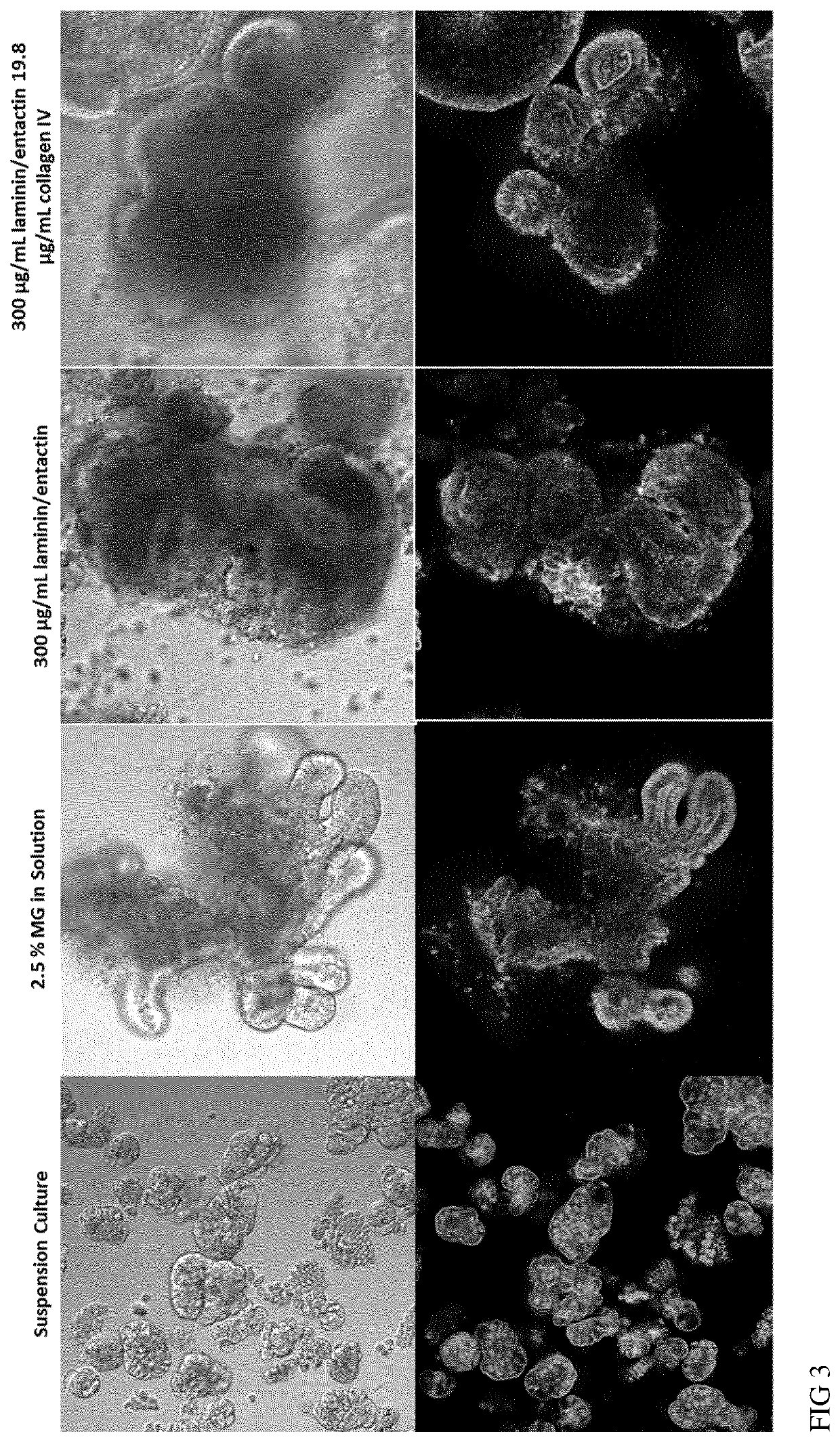Cell culture medium and method for generation of epithelial organoids from epithelial stem cells
a cell culture medium and stem cell technology, applied in the field of cell culture medium and method for generation of epithelial organoids from epithelial stem cells, to achieve the effect of facilitating handling/processing and enhancing growth
- Summary
- Abstract
- Description
- Claims
- Application Information
AI Technical Summary
Benefits of technology
Problems solved by technology
Method used
Image
Examples
embodiments
[0110]In an embodiment of the invention a suspension cell culture for obtaining an epithelial organoid is generated. The suspension culture may comprise
[0111]i) healthy epithelial stem cells, or tissue fragments comprising said epithelial stem cells
[0112]i) a basal medium for animal or human cells, e.g. advanced DMEM / F12
[0113]ii) a Bone Morphogenetic Protein (BMP) inhibitor, e.g. Noggin
[0114]iii) a mitogenic growth factor, e.g. EGF
[0115]iv) a soluble culture enhancer that induces correct polarization of the cells as disclosed herein, e.g. laminin / entactin in a concentration of 0.3 mg / ml, and
[0116]v) a Wnt agonist, e.g. R-spondin 1 and / or Wnt-3
[0117]The suspension culture develops within 2-4 days an organoid that is floating the cell culture.
[0118]The generated epithelial organoid may be used e.g. for analyzing the biology of healthy epithelial tissues, drug toxicity screening or their application in regenerative medicine.
[0119]In an embodiment of the invention a suspension cell cult...
example 1
nhancers Allow for Formation of Organoids Independent of Media Viscosity
[0194]In order to grow small intestinal organoids from small intestinal crypts, the crypts were harvested from the small intestine from C57B16 mice according to published procedures. In brief, after dissecting the small intestine, it was flushed with buffer, longitudinally opened and cut into pieces of approx. 4 mm and incubated in D-PBS containing 7 mM EDTA for 30 minutes on ice. Next, the crypts were released by repeated pipetting and harvested by letting remnant tissue pieces settle down by gravity and harvesting the supernatant containing crypts and some villi. The villi were removed by filtration though a SmartStrainer (Miltenyi Biotec) of 70 μm mesh size. The isolated crypts were centrifuged, resuspended in small intestinal organoid medium and seeded in ultra-low attachment plates. To test the capability of supporting organoid formation and growth, different supplements were added. Crypts incubated without...
example 2
ntactin and EHS Tumor Derived Molecules can Function as Culture Enhancers
[0195]Matrigel is a complex, less defined mixture of different ECM components such as collagens and laminins, as well as some growth factors such as EGF. In order to identify components of the Matrigel supporting formation and growth of small intestinal organoids, crypts were isolated from the small intestine of C57B16 mice and resuspended in small intestinal organoid medium. The crypts were seeded in ultra-low attachment plates. The addition of “composite Matrigel” consisting of collagen, laminin, entactin, fibronectin and hyaluronic acid, mimicking Matrigel addition, lead to the formation of budding organoids. Surprisingly, also the addition of collagen IV and laminin / entactin complex, as well as the addition of laminin / entactin only lead to the formation of budding organoids, as shown in FIG. 2.
PUM
| Property | Measurement | Unit |
|---|---|---|
| concentration | aaaaa | aaaaa |
| concentration | aaaaa | aaaaa |
| concentration | aaaaa | aaaaa |
Abstract
Description
Claims
Application Information
 Login to View More
Login to View More - R&D
- Intellectual Property
- Life Sciences
- Materials
- Tech Scout
- Unparalleled Data Quality
- Higher Quality Content
- 60% Fewer Hallucinations
Browse by: Latest US Patents, China's latest patents, Technical Efficacy Thesaurus, Application Domain, Technology Topic, Popular Technical Reports.
© 2025 PatSnap. All rights reserved.Legal|Privacy policy|Modern Slavery Act Transparency Statement|Sitemap|About US| Contact US: help@patsnap.com



